Top Rankings
Georgetown 01 School District ranks among the top 20% of public school district in South Carolina for:
Category
Attribute
Student Attention
Lowest student:teacher ratio (Top 1%)
For the 2025 school year, there are 9 public preschools serving 3,401 students in Georgetown 01 School District. This district's average pre testing ranking is 4/10, which is in the bottom 50% of public pre schools in South Carolina.
Public Preschools in Georgetown 01 School District have an average math proficiency score of 33% (versus the South Carolina public pre school average of 45%), and reading proficiency score of 36% (versus the 48% statewide average).
Minority enrollment is 56% of the student body (majority Black), which is more than the South Carolina public preschool average of 54% (majority Black).
Overview
This School District
This State (SC)
# Schools
19 Schools
578 Schools
# Students
8,355 Students
307,049 Students
# Teachers
696 Teachers
22,837 Teachers
Student : Teacher Ratio
12:1
12:1
District Rank
Georgetown 01 School District, which is ranked within the bottom 50% of all 76 school districts in South Carolina (based off of combined math and reading proficiency testing data) for the 2021-2022 school year.
The school district's graduation rate of 87% has decreased from 90% over five school years.
Overall District Rank
#47 out of 81 school districts
(Bottom 50%)
(Bottom 50%)
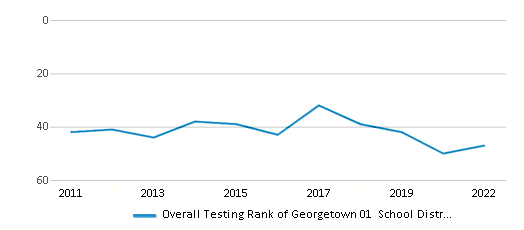
Math Test Scores (% Proficient)
30%
41%
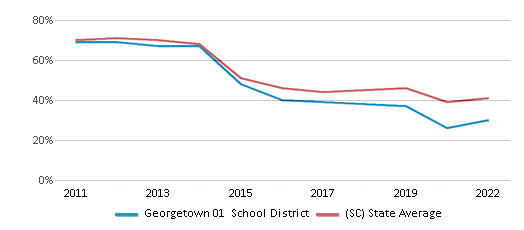
Reading/Language Arts Test Scores (% Proficient)
44%
52%
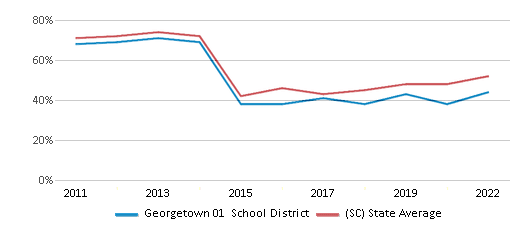
Science Test Scores (% Proficient)
40%
50%
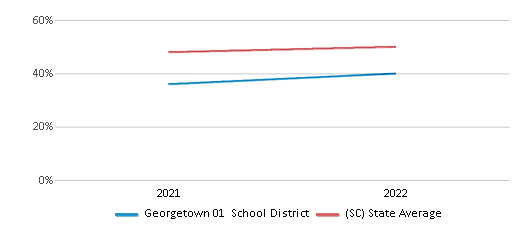
Graduation Rate
87%
84%

Students by Ethnicity:
Diversity Score
0.60
0.67
# American Indian Students
9 Students
905 Students
% American Indian Students
n/a
n/a
# Asian Students
33 Students
4,942 Students
% Asian Students
n/a
1%
# Hispanic Students
653 Students
41,883 Students
% Hispanic Students
8%
14%
# Black Students
3,468 Students
97,124 Students
% Black Students
42%
32%
# White Students
3,998 Students
140,483 Students
% White Students
48%
46%
# Hawaiian Students
6 Students
402 Students
% Hawaiian Students
n/a
n/a
# Two or more races Students
188 Students
21,254 Students
% of Two or more races Students
2%
7%
Students by Grade:
# Students in PK Grade:
306
27,258
# Students in K Grade:
544
46,285
# Students in 1st Grade:
602
47,365
# Students in 2nd Grade:
588
48,243
# Students in 3rd Grade:
560
43,895
# Students in 4th Grade:
628
43,663
# Students in 5th Grade:
604
40,854
# Students in 6th Grade:
605
3,355
# Students in 7th Grade:
627
2,477
# Students in 8th Grade:
637
2,190
# Students in 9th Grade:
771
439
# Students in 10th Grade:
671
373
# Students in 11th Grade:
675
325
# Students in 12th Grade:
537
327
# Ungraded Students:
-
-
District Revenue and Spending
The revenue/student of $16,789 is higher than the state median of $15,220. The school district revenue/student has stayed relatively flat over four school years.
The school district's spending/student of $19,058 is higher than the state median of $14,817. The school district spending/student has stayed relatively flat over four school years.
Total Revenue
$140 MM
$12,084 MM
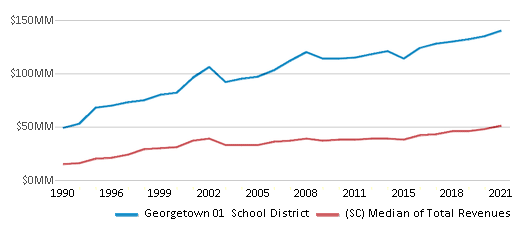
Spending
$159 MM
$11,764 MM

Revenue / Student
$16,789
$15,220

Spending / Student
$19,058
$14,817
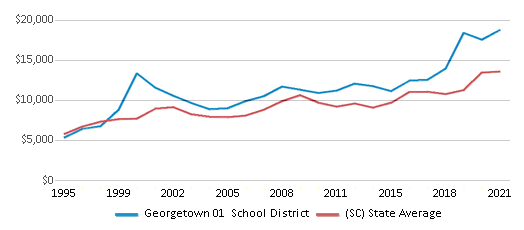
Best Georgetown 01 School District Public Preschools (2025)
School
(Math and Reading Proficiency)
(Math and Reading Proficiency)
Location
Grades
Students
Rank: #11.
Waccamaw Elementary School
(Math: 65-69% | Reading: 75-79%)
Rank:
Rank:
9/
Top 20%10
1364 Waverly Road
Pawleys Island, SC 29585
(843) 237-4233
Pawleys Island, SC 29585
(843) 237-4233
Grades: PK-3
| 540 students
Rank: #22.
Pleasant Hill Elementary Stream Academy
(Math: 50-54% | Reading: 45-49%)
Rank:
Rank:
6/
Top 50%10
127 Schoolhouse Road
Hemingway, SC 29554
(843) 558-9417
Hemingway, SC 29554
(843) 558-9417
Grades: PK-5
| 290 students
Rank: #33.
Kensington Elementary School
(Math: 40% | Reading: 38%)
Rank:
Rank:
4/
Bottom 50%10
86 Kensington Boulevard
Georgetown, SC 29440
(843) 546-8511
Georgetown, SC 29440
(843) 546-8511
Grades: PK-5
| 565 students
Rank: #44.
Sampit Elementary School
(Math: 30-34% | Reading: 30-34%)
Rank:
Rank:
3/
Bottom 50%10
69 Woodland Avenue
Georgetown, SC 29440
(843) 527-4411
Georgetown, SC 29440
(843) 527-4411
Grades: PK-5
| 283 students
Rank: #55.
Maryville Elementary School
(Math: 25-29% | Reading: 30-34%)
Rank:
Rank:
3/
Bottom 50%10
2125 Poplar Street
Georgetown, SC 29440
(843) 546-8423
Georgetown, SC 29440
(843) 546-8423
Grades: PK-5
| 477 students
Rank: #66.
Brown's Ferry Elementary School For The Creative And Perform
(Math: 20-24% | Reading: 35-39%)
Rank:
Rank:
3/
Bottom 50%10
7292 Brown's Ferry Road
Georgetown, SC 29440
(843) 527-1325
Georgetown, SC 29440
(843) 527-1325
Grades: PK-5
| 149 students
Rank: #77.
Mcdonald Elementary School
(Math: 20-24% | Reading: 25-29%)
Rank:
Rank:
2/
Bottom 50%10
532 Mcdonald Road
Georgetown, SC 29440
(843) 527-3485
Georgetown, SC 29440
(843) 527-3485
Grades: PK-5
| 386 students
Rank: #88.
Andrews Elementary School
(Math: 24% | Reading: 26%)
Rank:
Rank:
2/
Bottom 50%10
13072 County Line Road
Andrews, SC 29510
(843) 264-3419
Andrews, SC 29510
(843) 264-3419
Grades: PK-5
| 634 students
Rank: #99.
Plantersville Elementary Digital Immersion
(Math: 11-19% | Reading: 20-29%)
Rank:
Rank:
1/
Bottom 50%10
1668 Exodus Drive
Georgetown, SC 29440
(843) 546-8453
Georgetown, SC 29440
(843) 546-8453
Grades: PK-5
| 77 students
Recent Articles

What Is A Charter School?
Explore the world of charter schools in this comprehensive guide. Learn about their history, how they operate, and the pros and cons of this educational innovation. Discover key facts about charter schools, including admission policies, demographics, and funding, as well as what to look for when considering a charter school for your child.

10 Reasons Why High School Sports Benefit Students
Discover the 10 compelling reasons why high school sports are beneficial for students. This comprehensive article explores how athletics enhance academic performance, foster personal growth, and develop crucial life skills. From improved fitness and time management to leadership development and community representation, learn why participating in high school sports can be a game-changer for students' overall success and well-being.

February 05, 2025
Understanding the U.S. Department of Education: Structure, Impact, and EvolutionWe explore how the Department of Education shapes American education, from its cabinet-level leadership to its impact on millions of students, written for general audiences seeking clarity on this vital institution.





